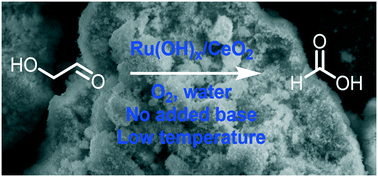Selective formation of formic acid from biomass-derived glycolaldehyde with supported ruthenium hydroxide catalysts†
Abstract
Ceria-supported ruthenium hydroxide catalysts, Ru(OH)x/CeO2, comprising micro- and nanoparticle supports were prepared, characterized and examined for the catalytic aerobic oxidation of glycolaldehyde (GAD) to formic acid (FA) in water under mild and base-free conditions. Under optimized reaction conditions, both of the examined catalyst types gave a high FA yield of around 80% at full GAD conversion with low CO2 formation (>95% carbon balance), while intermediate oxidation products were obtained under milder conditions and humins dominated under harsher conditions. The nanoparticle catalysts were more active than analogous catalysts based on microparticle ceria, which had a lower BET surface area and lower content of surface Ru(OH)x species relative to other Ru species. Notably, the superior nanoparticle-based catalyst also proved to be reusable in three consecutive reaction runs with essentially unchanged catalytic performance. This study demonstrates a benign and green protocol to convert GAD – a versatile platform molecule obtainable from biomass-derived carbohydrates – into the large-volume commodity chemical FA which has multiple industrial applications.



 Please wait while we load your content...
Please wait while we load your content...